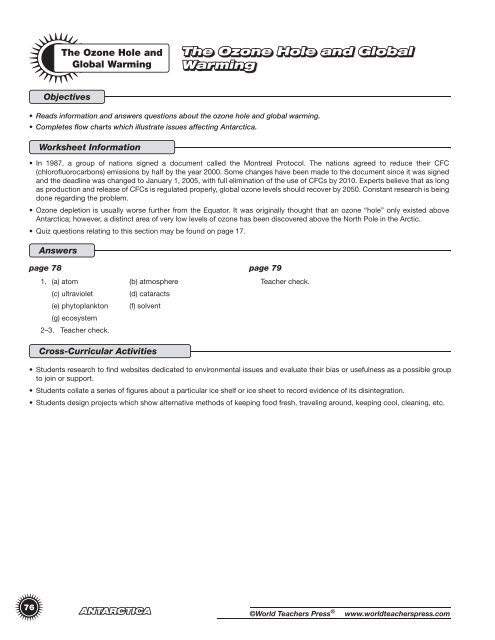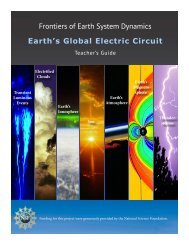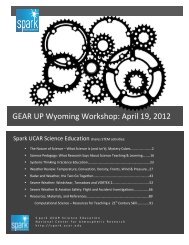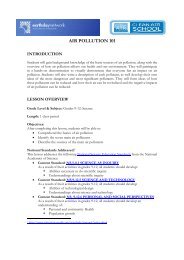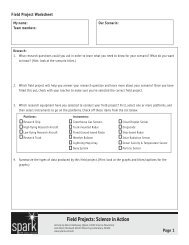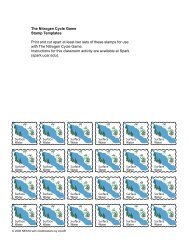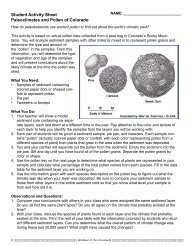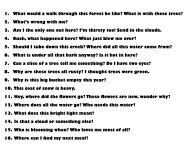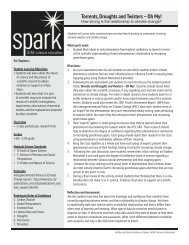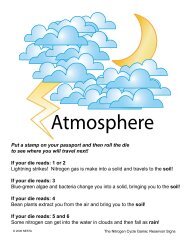The Ozone Hole and Global Warming.pdf - Spark
The Ozone Hole and Global Warming.pdf - Spark
The Ozone Hole and Global Warming.pdf - Spark
Create successful ePaper yourself
Turn your PDF publications into a flip-book with our unique Google optimized e-Paper software.
<strong>The</strong> <strong>Ozone</strong> <strong>Hole</strong> <strong>and</strong><br />
<strong>Global</strong> <strong>Warming</strong><br />
<strong>The</strong> <strong>Ozone</strong> <strong>Hole</strong> <strong>and</strong> <strong>Global</strong><br />
<strong>Warming</strong><br />
Objectives<br />
• Reads information <strong>and</strong> answers questions about the ozone hole <strong>and</strong> global warming.<br />
• Completes flow charts which illustrate issues affecting Antarctica.<br />
Worksheet Information<br />
• In 1987, a group of nations signed a document called the Montreal Protocol. <strong>The</strong> nations agreed to reduce their CFC<br />
(chlorofluorocarbons) emissions by half by the year 2000. Some changes have been made to the document since it was signed<br />
<strong>and</strong> the deadline was changed to January 1, 2005, with full elimination of the use of CFCs by 2010. Experts believe that as long<br />
as production <strong>and</strong> release of CFCs is regulated properly, global ozone levels should recover by 2050. Constant research is being<br />
done regarding the problem.<br />
• <strong>Ozone</strong> depletion is usually worse further from the Equator. It was originally thought that an ozone “hole” only existed above<br />
Antarctica; however, a distinct area of very low levels of ozone has been discovered above the North Pole in the Arctic.<br />
• Quiz questions relating to this section may be found on page 17.<br />
Answers<br />
page 78<br />
1. (a) atom (b) atmosphere<br />
(c) ultraviolet<br />
(d) cataracts<br />
(e) phytoplankton (f) solvent<br />
(g) ecosystem<br />
2–3. Teacher check.<br />
page 79<br />
Teacher check.<br />
Cross-Curricular Activities<br />
• Students research to find websites dedicated to environmental issues <strong>and</strong> evaluate their bias or usefulness as a possible group<br />
to join or support.<br />
• Students collate a series of figures about a particular ice shelf or ice sheet to record evidence of its disintegration.<br />
• Students design projects which show alternative methods of keeping food fresh, traveling around, keeping cool, cleaning, etc.<br />
76<br />
ANTARCTICA ©World Teachers Press ® www.worldteacherspress.com
<strong>The</strong> <strong>Ozone</strong> <strong>Hole</strong> <strong>and</strong> <strong>Global</strong><br />
<strong>Warming</strong> – 1<br />
<strong>The</strong> <strong>Ozone</strong> <strong>Hole</strong> <strong>and</strong><br />
<strong>Global</strong> <strong>Warming</strong><br />
Antarctica is one of the world’s greatest wildernesses. It is<br />
also greatly vulnerable to environmental changes as the result<br />
of human interference. <strong>The</strong> most signifi cant of these changes<br />
is the depletion of the ozone layer, creating an ozone “hole”<br />
(really a thin area rather than a hole) over Antarctica, <strong>and</strong> global<br />
warming.<br />
<strong>The</strong> Antarctic <strong>Ozone</strong> <strong>Hole</strong><br />
<strong>Ozone</strong> is a gas made up of three oxygen atoms.<br />
Most ozone can be found in the upper layer of the<br />
Earth’s atmosphere, called the stratosphere, which<br />
starts between about 6 <strong>and</strong> 8 miles <strong>and</strong> continues to<br />
around 30 miles.<br />
<strong>Ozone</strong> close to the Earth is harmful as it is a major<br />
component of smog <strong>and</strong> affects the function of<br />
the lungs. <strong>The</strong> ozone layer, however, protects the<br />
Earth from the harmful effects of ultraviolet rays from<br />
the sun. A decrease in the ozone layer could have<br />
harmful effects including:<br />
• Skin cancer.<br />
• Eye damage, such as cataracts.<br />
• Damage to the immune systems of organisms.<br />
• Reduction of the growth of phytoplankton in<br />
the oceans.<br />
• Damage to DNA in various life forms.<br />
• An adverse impact on crops <strong>and</strong> animals.<br />
• Cooling of the Earth’s stratosphere.<br />
Scientists have noticed that in recent years the<br />
ozone layer at the South Pole has begun to thin<br />
or reduce in concentration. This is the result of<br />
pollutants in the atmosphere destroying ozone in the<br />
stratosphere.<br />
<strong>The</strong> greatest cause of ozone breakdown is a<br />
group of chemicals called chlorofl uorocarbons<br />
(CFCs) which are manufactured chemicals found<br />
in refrigeration systems, air conditioners, aerosol<br />
cans (in some countries), solvents <strong>and</strong> packaging.<br />
<strong>The</strong> other cause is nitrogen oxides, which are a<br />
by-product of fuel burning <strong>and</strong> ejected from aircraft<br />
exhausts. <strong>The</strong> only way to control ozone thinning<br />
is to reduce the production of CFCs <strong>and</strong> nitrogen<br />
oxides. (In many countries, CFC use in aerosol cans<br />
is now prohibited.)<br />
<strong>Global</strong> <strong>Warming</strong><br />
<strong>Global</strong> warming is an increase in the average<br />
temperature of the Earth’s atmosphere,<br />
leading to climate change. It is thought by<br />
many to be caused by our use of fossil fuels<br />
such as oil, gas <strong>and</strong> coal.<br />
<strong>The</strong> main problem with rising temperatures<br />
is that Antarctic icecaps shrink. This in turn<br />
accelerates global warming, as the snow <strong>and</strong><br />
ice which usually form a protective, cooling<br />
layer over the Antarctic is lessened, allowing<br />
the Earth to absorb more sunlight <strong>and</strong> get<br />
hotter.<br />
In Antarctica, global warming has caused<br />
ice shelves to disintegrate, collapse or break<br />
up, ocean temperatures to increase <strong>and</strong><br />
ice thickness to decrease. In the Antarctic<br />
Peninsula region, an increase in annual<br />
temperature has caused the spread of the<br />
two fl owering plants in the last few decades.<br />
Numbers of Adelie penguins have declined<br />
steadily as the pack ice they live on is<br />
shrinking. Chinstrap <strong>and</strong> Gentoo penguins<br />
have begun to take their place, as the new<br />
nesting sites become more suited to them.<br />
Krill numbers are decreasing because of a fall<br />
in the amount of sea ice, where they feed on<br />
algae under the surface. As krill form a vital<br />
part of the food chain in Antarctica, this will<br />
have a huge impact on the other species in<br />
the oceans.<br />
<strong>The</strong>se two problems are having a great impact<br />
on an area rich in unique ecosystems.<br />
©World Teachers Press ®<br />
www.worldteacherspress.com<br />
ANTARCTICA<br />
77
<strong>The</strong> <strong>Ozone</strong> <strong>Hole</strong> <strong>and</strong><br />
<strong>Global</strong> <strong>Warming</strong><br />
<strong>The</strong> <strong>Ozone</strong> <strong>Hole</strong> <strong>and</strong> <strong>Global</strong><br />
<strong>Warming</strong> – 2<br />
Use the text on page 77 to answer the questions.<br />
1. Write words which match the meanings.<br />
(a) the smallest part of an element that can take<br />
part in a chemical reaction<br />
(b) the gaseous envelope surrounding the Earth<br />
(c) invisible rays of the spectrum with wavelengths shorter than violet<br />
(d) an abnormality of the eye characterized by opaque lenses<br />
(e) the plant component of plankton, which includes fungi, algae, bacteria <strong>and</strong><br />
yeasts<br />
(f) something with the power to dissolve<br />
(g) a community of organisms interacting with one another <strong>and</strong> with the<br />
environment in which they live<br />
2. Write your own explanation for the following terms:<br />
(a) <strong>The</strong> ozone hole is<br />
(b) <strong>Global</strong> warming is<br />
3. Complete the boxes using brief bullet points.<br />
Cause Effect Solution<br />
<strong>The</strong> <strong>Ozone</strong><br />
<strong>Hole</strong><br />
<strong>Global</strong><br />
<strong>Warming</strong><br />
Fact File<br />
If all the ozone above your head was collected in a continuous layer, it would<br />
only be about 3 or 5 mm thick!<br />
78<br />
ANTARCTICA ©World Teachers Press ® www.worldteacherspress.com
Environmental Issues<br />
Flow Charts<br />
<strong>The</strong> <strong>Ozone</strong> <strong>Hole</strong> <strong>and</strong><br />
<strong>Global</strong> <strong>Warming</strong><br />
1. Research <strong>and</strong> draw flow charts to illustrate:<br />
(a) How CFCs cause the ozone layer to breakdown.<br />
(b) How global warming changes the Earth’s climate.<br />
Fact File<br />
Strong winds blowing around Antarctica form a “polar vortex” which<br />
isolates air over Antarctica from the rest of the world. This helps to<br />
make the ozone hole worse!<br />
©World Teachers Press ®<br />
www.worldteacherspress.com<br />
ANTARCTICA<br />
79


